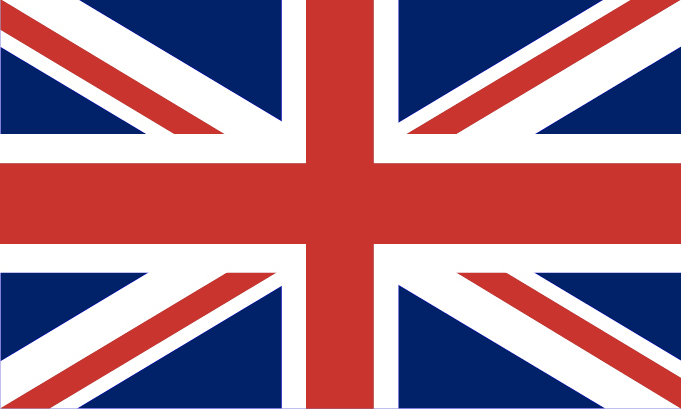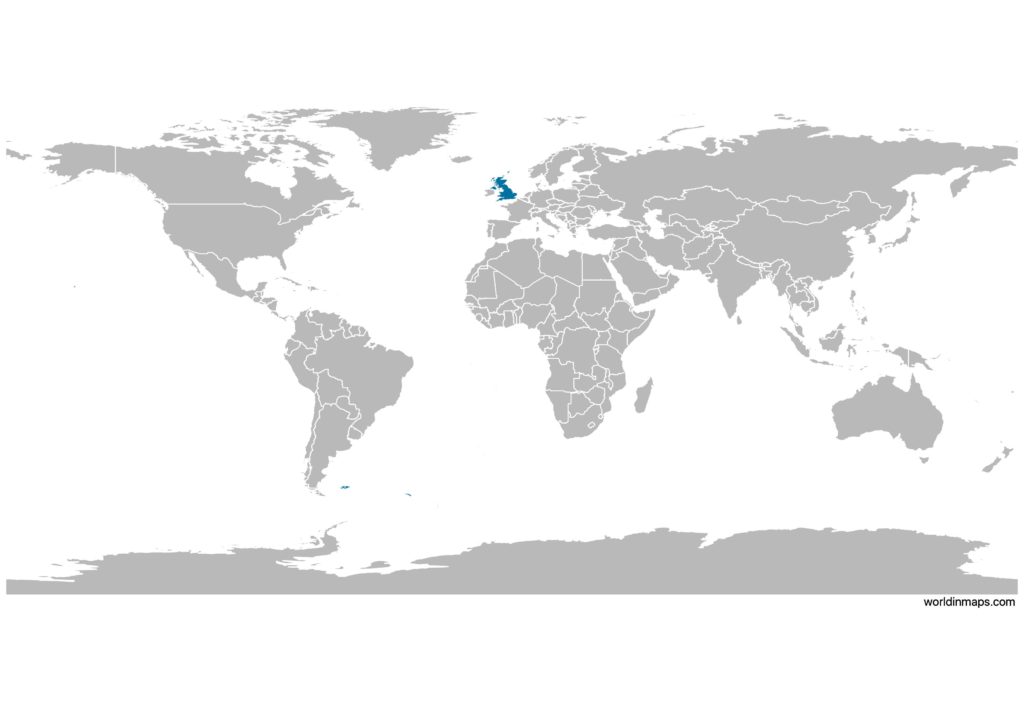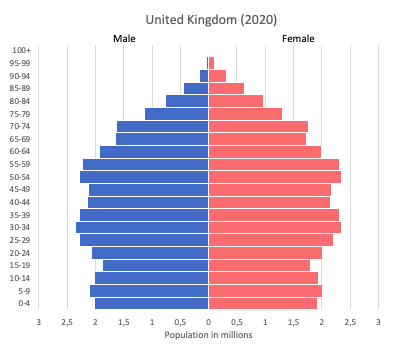United Kingdom (UK)

| Government | |
| Name | United Kingdom of Great Britain and Northern Ireland |
| Government type | parliamentary constitutional monarchy (a Commonwealth realm) |
| Capital | London (7,556,900) |
| Currency | Pound sterling (GBP) |
| Organization | |
| Member State | Commonwealth of Nations |
| People | |
| Population (2020) | 67,886,004 (21st) |
| Density of population | 270.7 P/km2 (50th) |
| Nationality | British |
| Official languages | |
| English | |
| Ethnic groups (2011) | |
| white | 87.1% |
| Asian | 7.0% |
| Black | 3.0% |
| Mixed | 2.0% |
| Others | 0.9% |
| Religions (2011) | |
| Christian | 59.5% |
| Muslim | 4.4% |
| Hindu | 1.3% |
| other | 2% |
| unspecified | 7.2% |
| none | 25.7% |
| Life expectancy (2020) | |
| Male | 78.8 years |
| Female | 83.5 years |
| Total population | 81.1 years (40th) |
| Homicides | |
| Total (2018) | 1.2 per 100,000 people (130th) |
| Geography | |
| Land area | 241,930 km2 |
| water area | 1,680 km2 |
| total area | 243,610 km2 (81st) |
| Percentage for the 4 UK countries: England – 53% Scotland – 32% Wales – 9% Northern Ireland – 6% | |
| Mean elevation | 162 m |
| Lowest point | |
| The Fens | -4 m |
| Highest point | |
| Ben Nevis | 1,345 m |
| Land use (2011) | |
| Agricultural land | 71% |
| Arable land | 25.1% |
| Permanent crops | 0.2% |
| Permanent pasture | 45.7% |
| Forest | 11.9% |
| Other | 17.1% |
| Urbanization | |
| Urban population (2020) | 83.9% |
| Rate of urbanization | 0.89% annual rate of change (2015 – 2020) |
| Economy | |
| Labor force (2017) | 33.5 million (17th) |
| Labor force by occupation (2014) | |
| Agriculture | 1.3% |
| Industry | 15.2% |
| Services | 83.5% |
| Unemployment rate (2017) | 4.4% (61st) |
| GDP (PPP) (estimate 2019) | |
| Total | $3.131 trillion (9th) |
| Per capita | $46,827(26th) |
| GDP (nominal) (estimate 2019) | |
| Total | $2.744 trillion (6th) |
| Per capita | $41,030 (20th) |
| GDP by sector (estimate 2017) | |
| Agriculture | 0.7% |
| Industry | 20.2% |
| Services | 79.2% |
| Exports (2017) | $441.2 billion (10th) |
| Exports partners (2017) | |
| US | 13.2% |
| Germany | 10.5% |
| France | 7.4% |
| Netherlands | 6.2% |
| Ireland | 5.6% |
| China | 4.8% |
| Switzerland | 4.5% |
| Imports (2017) | $615.9 billion (5th) |
| Imports partners (2017) | |
| Germany | 13.7% |
| US | 9.5% |
| China | 9.3% |
| Netherlands | 8% |
| France | 5.4% |
| Belgium | 5% |
United Kingdom (UK) on the world map

United Kingdom top 10 largest cities
- London (7,556,900)
- Birmingham (984,333)
- Liverpool (864,122)
- Nottingham (729,977)
- Sheffield (685,368)
- Bristol (617,280)
- Glasgow (591,620)
- Leicester (508,916)
- Edinburgh (464,990)
- Leeds (455,123)
Demography
Population pyramid

Age structure data
Estimate for 2020:
- 0-14 years: 17.63% (male 5,943,435/female 5,651,780)
- 15-24 years: 11.49% (male 3,860,435/female 3,692,398)
- 25-54 years: 39.67% (male 13,339,965/female 12,747,598)
- 55-64 years: 12.73% (male 4,139,378/female 4,234,701)
- 65 years and over: 18.48% (male 5,470,116/female 6,681,311)
Remark: the age structure of a population affects a nation’s key socioeconomic issues. Countries with young populations (high percentage under age 15) need to invest more in schools, while countries with older populations (high percentage ages 65 and over) need to invest more in the health sector. The age structure can also be used to help predict potential political issues. For example, the rapid growth of a young adult population unable to find employment can lead to unrest.
Population from 1950 to 2020
Source: United Nations, Department of Economic and Social Affairs, Population Division (2019). World Population Prospects 2019, Online Edition. Rev. 1.
Evolution of the life expectancy from 1960 to 2018
Source: World Development Indicators, The World Bank
Major rivers
- Severn (354 km / 220 mi)
- Thames (346 km / 215 mi)
- Trent (297 km / 185 mi)
- Great Ouse (230 km / 143 mi)
- Wye (215 km / 134 mi)
Economy
Agriculture:
cereals, oilseed, potatoes, vegetables; cattle, sheep, poultry; fish; milk, eggs
Industries:
machine tools, electric power equipment, automation equipment, railroad equipment, shipbuilding, aircraft, motor vehicles and parts, electronics and communications equipment, metals, chemicals, coal, petroleum, paper and paper products, food processing, textiles, clothing, other consumer goods
Exports – commodities:
manufactured goods, fuels, chemicals; food, beverages, tobacco
Imports – commodities:
manufactured goods, machinery, fuels; foodstuffs
Time zone and current time in UK
Go to our interactive map to get the current time in UK